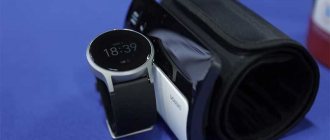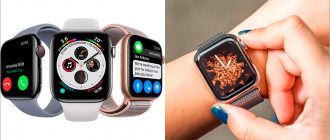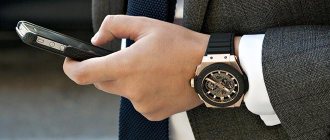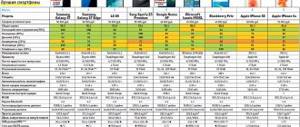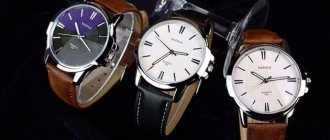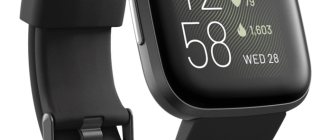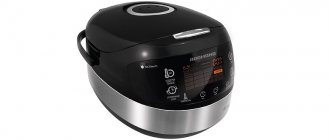The constant development of information technology leads to the emergence of new gadgets. In addition to the usual smartphones and tablets, miniature devices are popular in the electronics market.
Therefore, the logical question of what is better to buy: a smart watch or a fitness bracelet is especially relevant now.
The difference between the presented options is quite large, as is the price. In this article, we will analyze for what purposes these gadgets are best suited, list their main functions and technical characteristics, and software. A comparative analysis of devices will help you choose the best option.
The main purposes of using a gadget: which is best?
A fitness bracelet is the optimal device for active people. Such a gadget has a number of built-in sensors that record certain physiological indicators of the owner. The bracelet is capable of:
- calculate movement speed;
- heartbeat;
- duration and nature of physical activity;
- calories burned;
- quality of sleep.
The tracker connects to a personal smartphone via a Bluetooth module. Thanks to active sleep analysis and recording of pulse measurements and involuntary movements, the bracelet can implement the function of a “smart” alarm clock. The main idea: the device will wake you up during REM sleep for easy awakening and well-being.
Thanks to moisture protection, 90% of modern bracelet models can withstand contact with water, and some can accompany the owner during swimming training.
Note! To fully swim with a bracelet, you need to choose a protection level of 20 ATM, and for regular running in the rain, gadgets with a moisture protection of 3 ATM are suitable.
Smart watches have much greater capabilities compared to a sports tracker. In addition to monitoring activity (as in the previous version), among the main purposes of using such a watch are the following:
- For quick access to information. To watch something on your smartphone, you need to take it out, unlock it, and launch the appropriate application. “Smart” watches greatly simplify the situation - thanks to widgets, on their screen you can quickly get the necessary information at one glance at the display.
- For equipment management and more. Such a gadget will help configure the operation of any device/program: from an audio player on a personal smartphone to a TV or an entire “smart” home. The creators of various cars also participated in the future synchronization of clocks and cars. At the moment, this feature is implemented in a number of Apple devices. Using the functionality of such a watch, you can lock doors, control the remaining fuel or battery, in the case of an electric car, adjust the temperature inside the cabin, etc., just by installing the desired application.
- To perform tasks “without hands” (hands free). Smart watches are literally created to make life easier for motorists or in other cases when you can’t pick up a smartphone and do what you need. Using the Siri system on Apple Watch, you can easily make calls, send SMS (voice and text), set reminders, and perform a large number of other tasks. Similar functionality is available on watches with the Android operating system: in addition to the above, the owner will be able to receive a translation from one language to another with a voice command, find out the exchange rate, or write to a friend even in a third-party messenger.
Be sure to check out:
The fitness bracelet does not count steps. The main reasons for breakdowns of the pedometer, heart rate monitor and calorie counter IWOWN I6 Pro - a budget, multifunctional and high-quality fitness bracelet for tracking sports activity Xiaomi Mi Band 2 fitness bracelet: water test How to remove the strap from a fitness bracelet: rules and nuances
Fitness bracelet and smart watch: what are the purposes of use
So, the first thing we will start our comparison with is to look at their functionality and features.
Why do you need a fitness bracelet?
The fitness bracelet is designed for people leading an active and sporty lifestyle. It is capable of monitoring and recording a number of physiological indicators, thanks to built-in sensors.
Appearance of the Xiaomi mi band 4 fitness bracelet
What can a fitness bracelet do?
- Calculating the speed of a person's movement;
- Heart rate (number of heart beats per minute);
- Duration of physical activity;
- Training intensity;
- Number of calories burned;
- Quality and duration of sleep;
- Number of steps taken;
- “Smart” alarm clock - this function is responsible for waking up a person during the REM sleep phase, that is, at the moment of his easy awakening;
- Timer, stopwatch and alarm functions;
- Notification of calls and messages to your phone.
The fitness bracelet is connected to a suitable smartphone via Bluetooth, and it, in turn, transmits data on physical activity to a suitable application, for example, for Samsung models it is SHeath. And they, in turn, are displayed on the phone.
Also, almost all modern models of fitness bracelets have an increased level of protection against moisture, which will allow them to remain on you, even if your workouts take place in water or a pool.
Why do you need a smart watch?
Smartwatches or smartwatches are gadgets that have more functionality than fitness bracelets, as they are designed not only to track physical activity, but also to fully interact with a smartphone.
Appearance of smart watches
What can smart watches do?
- Quick access to information - notifications about calls, SMS messages, notifications in instant messengers and more are displayed on the screen. And all this is shown on the display;
- Full smartphone control: music, stopwatch, alarm clock, timer, time and calendar, weather forecast and more;
- Shows the complete physical activity of a person (functions of a fitness bracelet);
- Call another phone without a smartphone and send messages;
- Determine location using GPS;
- The “hands free” or “hands free” function, that is, with the help of a voice assistant, such as Siri in Apple smartphones, you can easily carry out commands without removing the phone from your pocket or bag.
Thus, you can see that smart watches have many more features and functions than fitness bands. Therefore, if you want to track your physical activity, then pay attention to fitness bracelets.
Next we will look at the design and appearance.
What is the difference between the appearance of the devices?
Fitness trackers and smart watches differ not only in a number of functions, but also in appearance:
- Screen. The display of fitness bracelets is small or completely absent. However, only some models offer the ability to touch control the gadget, and the screen itself offers only black and white colors and a few bright tones. Smart watches, on the contrary, have a large display with support for touch control. The screen is fully color, and the picture quality can compete with a smartphone.
- Strap. The trackers include a silicone or rubber strap; some models allow the bracelet to be changed, depending on the wishes of the owner. Smart watches have acquired a more expensive and stylish strap: manufacturers use special metal alloys, leather, etc.
- Size. Fitness bracelets are distinguished by their small size and ergonomic shape - when worn regularly, such devices are absolutely not felt on your hand. Smart watches, due to their enlarged display, are much larger in size - users note their noticeable weight on the wrist, and some cannot sleep with such a gadget.
New models of fitness bracelets are increasingly equipped with a color screen, and its size is gradually increasing by manufacturers.
Types of fitness bracelets
Fitness bracelets can be divided into two categories:
- Activity trackers.
- Smart bracelet.
Trackers, in turn, can be divided into several categories, since they are usually gadgets with a narrow specialization, focused on monitoring a specific indicator of activity or sport (for example, heart rate monitors, sleep monitors, trackers for swimming or running). Trackers don't necessarily look like a bracelet or a watch. They can be in the form of a clip, a clamp, a mat under the mattress (Withings Sleep), and even in the form of a sticker on the forehead (Beddr SleepTuner).
Smart bracelets or fitness trackers are more versatile and advanced gadgets. In addition to sports and fitness functions, they also have some smartwatch capabilities. For example, notifications about calls and messages, activity reminders, alarm clock, timer, stopwatch, etc. Typically, fitness bracelets are equipped with a small screen.
The most famous manufacturers of trackers and fitness bracelets include the following companies:
- Fitbit.
- Garmin.
- Polar.
- Samsung.
- Huawei.
- Xiaomi.
Comparison table of smart watch and tracker functions
| Function | Fitness bracelet | Smart watch |
| Notifications | Able to vibrate when there is an incoming call or new notification. However, only in the latest models is it possible to reject a call through a bracelet or read the beginning of a message - in earlier versions of trackers this option was not available. | Show the name of the caller when there is an incoming call, give the opportunity to reject or accept it. The text of the notifications is almost completely readable. In addition, the watch makes it possible to receive information from several sources simultaneously, thanks to a modified system of widgets on the screen. |
| Pulse measurement | Thanks to a special sensor, the pulse is measured at a given time and at certain intervals (during sleep, activity), and then transmits the information to a smartphone application for detailed analysis. Models with a screen allow you to view your heart rate directly on the bracelet. | Data on the owner's pulse is measured at any interval, and statistical data can be viewed immediately on the display of the smart watch. |
| Activity | A built-in pedometer, motion sensor and other analyzers allow the fitness bracelet to collect data during training and count the number of steps taken. The statistics are sent directly to the smartphone - it is impossible to view a detailed analysis on the bracelet. | The watch has all the necessary sensors to monitor activity - while statistics are displayed on the screen in real time, which allows the owner to make adjustments to the usual training scenario. |
| “Smart” alarm clock | This function is available by default only on early versions of fitness bracelets. For updated models, you need to download a special application that will allow the bracelet to wake up the owner in the REM sleep phase (for an easy awakening process). | Smart watches have this feature by default. However, due to the bulky design, not all users can sleep with them on their wrist, which is why this function is simply lost. |
| Display time, weather and other widgets | Valid only for models with a screen. Information about time and weather conditions is displayed on different desktops and can be accessed by swiping. | Smart watches have a large screen, thanks to which you can view the weather, exchange rates, etc. at any time. when you first look at the screen. Information is placed in the form of customizable widgets. |
Smart watch or fitness bracelet: pros and cons
The following table will help you make your choice:
| Options | Fitness bracelet | Smart watch |
| Price | From RUB 550 to RUB 25,000 * | From 650 rubles to 240,000 rubles * |
| Call notification | Due to the small screen or its absence, the caller is not displayed; you will have to take out your smartphone to answer. | You will see who is calling and will be able to answer from the screen of your gadget. |
| Message Notification | The bracelet will vibrate, notifying you of a new message, but you can only read it on your phone. | Without taking out your mobile phone, you can read the message on the screen of your smart watch. |
| Pulse measurement | To activate the function, you need to go to the application and click on the appropriate button. | It all depends on the specific model. If the smartwatch is sporty, this function is present and works well. |
| Smart alarm clock | Tracking sleep stages and waking up at the most appropriate moment is an interesting feature. The bracelet is light, does not interfere with sleep, and copes with this task perfectly. | Many people note that using a smart watch as a smart alarm clock is inappropriate: it is inconvenient to sleep and wake up with them. |
| Autonomy | Operating time without recharging is from 1 to 1.5 months. | The charge lasts only 1 – 2 days. |
| Contactless payment | Many fitness bracelets are equipped with an NFC module, but in Russia you cannot use this function; we can say that it is useless. | You can pay for purchases by bringing your device to the terminal. Important! Not all smartwatches have NFC; check the specifications before purchasing. |
Not all smartwatches have NFC; check the specifications before purchasing.
*average price on Yandex Market
Software
The presence of special software makes wrist devices truly “smart”. Fitness bracelets, even if they have a screen, do not contain self-supporting software. They have a special microcode built inside them, which is focused on collecting information from various sensors and built-in sensors, as well as the subsequent transfer of information to a personal smartphone. The analysis process is carried out using an application on the phone, and not by the gadget itself.
Modern smartwatches have a seamless operating system with a well-thought-out interface that is adapted to the specifics of a small touch display. Such watches can independently analyze information and control other devices and equipment without the help of a smartphone.
Note! Among the most popular operating systems for smartwatches are Android, Android Wear, iOS and Tizen.
Why choose a fitness tracker
The main purpose of the fitness bracelet is to provide additional motivation for the user to adhere to the principles of regularity and progress in training. The variety of models of this device is very large, but all of them can be divided into budget and luxury models. Naturally, the latter have a much more impressive list of functions, but they all lose their value if the tracker does not fulfill its main purpose during operation.
Unlike smartwatches, using a tracker in conjunction with a special application does not imply that the phone is always within Bluetooth range. To put it simply, you can simply launch the appropriate program on your phone, and after training, the bracelet on your hand will send all the tracked data to the application. Another advantage of the tracker is that it holds a charge (thanks to the screen, which is often low-resolution) for quite a long time.
Reference! It is better to use a fitness tracker with the application, since only with it will it be possible to track progress over time. In addition, a good bracelet should be light and comfortable to wear.
Advantages and disadvantages
Among the main advantages of sports bracelets, we have highlighted the following:
- ergonomic shape and ease of use - the tracker is not felt on the hand even during night sleep;
- Accurate counting of steps, heart rate and calories for activity statistics;
- the presence of moisture protection in most models;
- the ability to control notifications;
- long battery life (about 1 month);
- low cost ($10-80).
The disadvantages of such models include the absence and small size of a screen, limited functionality and options for viewing data, and greater dependence on a smartphone.
Among the main advantages of smart watches we should mention:
- large color display with touch control;
- stylish design, use of metal and leather for the case and strap;
- the presence of a widget system for quick access to the necessary information;
- the ability to view various notifications, accept/reject calls;
- voice control function for the convenience of motorists;
- own activity data analysis system without connection to a smartphone.
Negative aspects of the work include the short battery life (only 1-2 days after a full charge), quite noticeable weight, bulky design and high price of the gadget (starts at $250).
What is the difference between a fitness bracelet and a smart watch?
Initially, fitness trackers were an ordinary mobile pedometer, which was offered in the form of a bracelet or a clip on clothes.
However, such a narrow profile suited few people, and manufacturers had to quickly expand the capabilities of this device.
Smart watches appeared much later. They contained all the functions of fitness bracelets plus additional capabilities for remote work with a synchronized smartphone.
There are differences between these two sports gadgets. Therefore, we strongly recommend that you study them before deciding whether to choose a smart watch or a fitness bracelet:
What features can be found in fitness trackers?
Depending on the model and price category, smart bracelets may have the following capabilities:
1. Determining the number of steps taken and the distance covered (in some gadgets it is possible to program a goal by steps/distance, after which you will receive notifications about its achievement).
2. Drawing the route and distance covered while running.
3. A heart rate monitor that shows whether you are training in the correct heart rate zone and whether there are any overloads.
4. Calculation of calories spent during activity with the ability to select the type of training for more accurate accounting.
5. Monitoring sleep quality, taking into account movements during sleep and changes in deep and superficial phases.
6. A smart alarm clock that can be programmed to sound exclusively in the shallow phase of sleep (it will be much easier for the owner of the gadget to wake up).
7. Selection of diet with calorie counting.
8. Geolocation to determine the location and build the optimal route for running/walking/cycling.
9. GPS navigation.
What functions can be found in Smart watches?
Most modern smartwatch models have all the functions of fitness trackers (depending on the model, they may have all of the above functions, or they may have some of them). However, there are features that are largely found in smartwatches and are rarely found in fitness trackers, for example:
– Notification of missed and incoming calls to the smartphone, remote reading of messages received on the phone, including Internet instant messengers (communication between devices is supported using the Bluetooth wireless system and a special application, which is easy to download in the free version).
– Internet access thanks to the autonomous built-in Wi-Fi module.
– Search for a lost smartphone using a signal or GPS navigation.
– Built-in camera with the ability to record video and photos.
– Built-in voice recorder.
– Ability to listen to music, including music stored on your smartphone.
– Manage your smartphone’s phone book and contact list.
– Making mobile calls from the SIM card installed in the watch, as well as the SIM card from the phone.
– NFC function, which allows you to pay using your hours for purchases in a store, provided that your bank supports such functionality.
– Hands-free calling using speaker and microphone, leaving your hands free while talking while driving.
What to choose
When choosing a smart watch or fitness bracelet, you need to understand that gadgets from these categories have a large number of common functions. At the same time, the capabilities of the bracelet are limited to a basic set for monitoring physical activity, notifications and other indicators, while the capabilities of smart watches are much wider, thanks to the presence of a separate operating system.
Interesting! However, with the introduction of a productive platform, the watch lost a lot of battery life compared to classic trackers: 1-2 days versus 25-30 days. At the same time, smart watches make it possible to use a smartphone less often and get an almost complete replacement (especially important for motorists, hikers, athletes, etc.).
If you need an assistant in sports activities and a basic set of functions for monitoring activity and health, feel free to purchase your favorite fitness bracelet. If you need a full-fledged replacement for your smartphone, which facilitates sports activities and solving work issues, it is better to take a closer look at smart watches.
Which wearable gadget is better to choose?
The question naturally arises as to what to choose in the end: a smart watch or a fitness bracelet.
Before choosing a particular option, you need to carefully study all the characteristics, features and built-in functions of the two wearable gadgets. Everyone decides for themselves what suits them best.
To help with your purchase, it's worth taking a look at the strengths and weaknesses of the two devices. As a result, the buyer will be able to decide exactly what is best in his case. Whether it will be a smart watch or a more compact fitness bracelet depends on the requirements, financial capabilities and some other components.
The advantages of bracelets include the following points:
- they are more affordable;
- have better autonomy, long-term operation without recharging;
- here are simplified settings;
- ease of operation due to a smaller set of functions;
- compact dimensions;
- less weight;
- ample opportunities for people involved in sports.
Fitness bracelets were originally designed for sports. Moreover, they are created for different sports, activities, etc. Here the choice depends on what exactly the specific person who purchases such a wearable gadget does.
But at the same time, bracelets also have their drawbacks. They appear as follows:
- they are not suitable for those for whom it is important to frequently receive and read notifications through a wearable device;
- devices rarely support wireless charging, which makes them less convenient;
- functionality is limited;
- You cannot connect the contactless payment function through the bracelet;
- Most models have a very small screen;
- Special straps are required for wearing.
As for smart watches, they are devoid of all the disadvantages of bracelets, but at the same time cannot boast of their advantages. This manifests itself in weak battery life, as well as limited options for sports fans.
Now smart watches are positioned more as a status gadget, which is a sign of wealth and demonstrates a certain level of the user. Although in fact this is just a successful marketing policy that forces people to buy such watches.
Fitness bracelets are bought mainly by sports fans and active people who want to get a device for monitoring their health, the ability to record certain sporting achievements, etc. Communication with a smartphone is, rather, an addition.
But smart watches are a smaller version of a smartphone. This is a device for communication, correspondence, calls. In fact, this is the same phone, only on the hand. In this case, health control and sports achievements are secondary and act as an additional function.
That is, buying a smart watch for running is not the best option, since it is preferable to use a fitness bracelet. And if the user needs to transfer the main functions of the phone to his hand, then it is more logical to purchase a smart watch.
Main conclusions
New electronics from various brands only fuel interest in fitness bracelets and smart watches. The choice of gadgets is largely determined by the goals of the future user. To choose the right device option, you should decide on the following points:
- necessary functionality (basic activity control or an extended list of functions for activity, business interaction and entertainment);
- sharing with a personal phone or its full replacement;
- estimated budget for future purchases;
- preferences regarding design and style;
- battery life after full charge.
Both types of wrist gadgets have a huge number of fans and users around the world. The need to purchase each depends on the capabilities, goals and preferences of a particular person. By comparing the characteristics of the two options, you can choose the right device.

